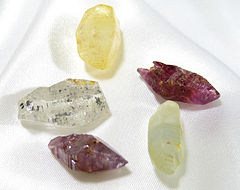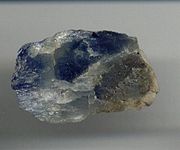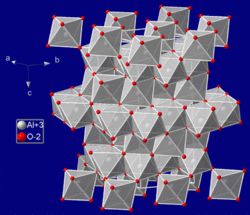
Corundum
About this schools Wikipedia selection
This selection is made for schools by a children's charity read more. With SOS Children you can choose to sponsor children in over a hundred countries
| Corundum | |
|---|---|
 |
|
| General | |
| Category | Oxide mineral – Hematite group |
| Formula (repeating unit) |
Aluminium oxide, Al2O3 |
| Strunz classification | 04.CB.05 |
| Dana classification | 4.3.1.1 |
| Crystal symmetry | Trigonal (32/m) |
| Unit cell | a = 4.75 Å, c = 12.982 Å; Z=6 |
| Identification | |
| Colour | Colorless, gray, brown; pink to pigeon-blood-red, orange, yellow, green, blue to cornflower blue, violet; may be colour zoned, asteriated mainly grey and brown |
| Crystal habit | Steep bipyramidal, tabular, prismatic, rhombohedral crystals, massive or granular |
| Crystal system | Trigonal (Hexagonal Scalenohedral) Symbol (32/m) Space group: R3c |
| Twinning | Polysynthetic twinning common |
| Cleavage | None – parting in 3 directions |
| Fracture | Conchoidal to uneven |
| Mohs scale hardness | 9 (defining mineral) |
| Luster | Adamantine to vitreous |
| Streak | White |
| Diaphaneity | Transparent, translucent to opaque |
| Specific gravity | 3.95–4.10 |
| Optical properties | Uniaxial (–) |
| Refractive index | nω = 1.767–1.772 nε = 1.759–1.763 |
| Pleochroism | None |
| Melting point | 2044 °C |
| Fusibility | Infusible |
| Solubility | Insoluble |
| Alters to | May alter to mica on surfaces causing a decrease in hardness |
| Other characteristics | May fluoresce or phosphoresce under UV |
| References | |
| Major varieties | |
| Sapphire | Any colour except red |
| Ruby | Red |
| Emery | Black granular corundum intimately mixed with magnetite, hematite, or hercynite |
Corundum is a crystalline form of aluminium oxide (Al2O3) with traces of iron, titanium and chromium. It is a rock-forming mineral. It is one of the naturally clear transparent materials, but can have different colors when impurities are present. Transparent specimens are used as gems, called ruby if red, while all other colors are called sapphire.
The name "corundum" is derived from the Tamil word குருந்தம் "kuruntam" meaning "ruby", itself derived from the Sanskrit "kuruvinda".
Because of corundum's hardness (pure corundum is defined to have 9.0 Mohs), it can scratch almost every other mineral. It is commonly used as an abrasive, on everything from sandpaper to large machines used in machining metals, plastics, and wood. Some emery is a mix of corundum and other substances, and the mix is less abrasive, with an average hardness near 8.0.
In addition to its hardness, corundum is unusual for its density of 4.02 g/cm3, which is very high for a transparent mineral composed of the low atomic mass elements aluminium and oxygen.
Geology and occurrence

Corundum occurs as a mineral in mica schist, gneiss, and some marbles in Metamorphic terranes. It also occurs in low silica igneous syenite and nepheline syenite intrusives. Other occurrences are as masses adjacent to ultramafic intrusives, associated with lamprophyre dikes and as large crystals in pegmatites. Because of its hardness and resistance to weathering, it commonly occurs as a detrital mineral in stream and beach sands. The largest documented single crystal of corundum measured about 65×40×40 cm.
Corundum for abrasives is mined in Zimbabwe, Russia, and India. Historically it was mined from deposits associated with dunites in North Carolina, USA and from a nepheline syenite in Craigmont, Ontario. Emery grade corundum is found on the Greek island of Naxos and near Peekskill, New York, USA. Abrasive corundum is synthetically manufactured from bauxite.
Synthetic corundum
In 1837, Gaudin made the first synthetic rubies by fusing alumina at a high temperature with a small amount of chromium as a pigment. In 1847, Ebelmen made white sapphires by fusing alumina in boric acid. In 1877 Frenic and Freil made crystal corundum from which small stones could be cut. Frimy and Auguste Verneuil manufactured artificial ruby by fusing BaF2 and Al2O3 with a little chromium at temperatures above 2,000 °C (3,632 °F). In 1903, Verneuil announced he could produce synthetic rubies on a commercial scale using this flame fusion process.
The Verneuil process allows the production of flawless single-crystal sapphires, rubies and other corundum gems of much larger size than normally found in nature. It is also possible to grow gem-quality synthetic corundum by flux-growth and hydrothermal synthesis. Because of the simplicity of the methods involved in corundum synthesis, large quantities of these crystals have become available on the market causing a significant reduction of price in recent years. Apart from ornamental uses, synthetic corundum is also used to produce mechanical parts (tubes, rods, bearings, and other machined parts), scratch-resistant optics, scratch-resistant watch crystals, instrument windows for satellites and spacecraft (because of its transparency from the UV to IR), and laser components.

